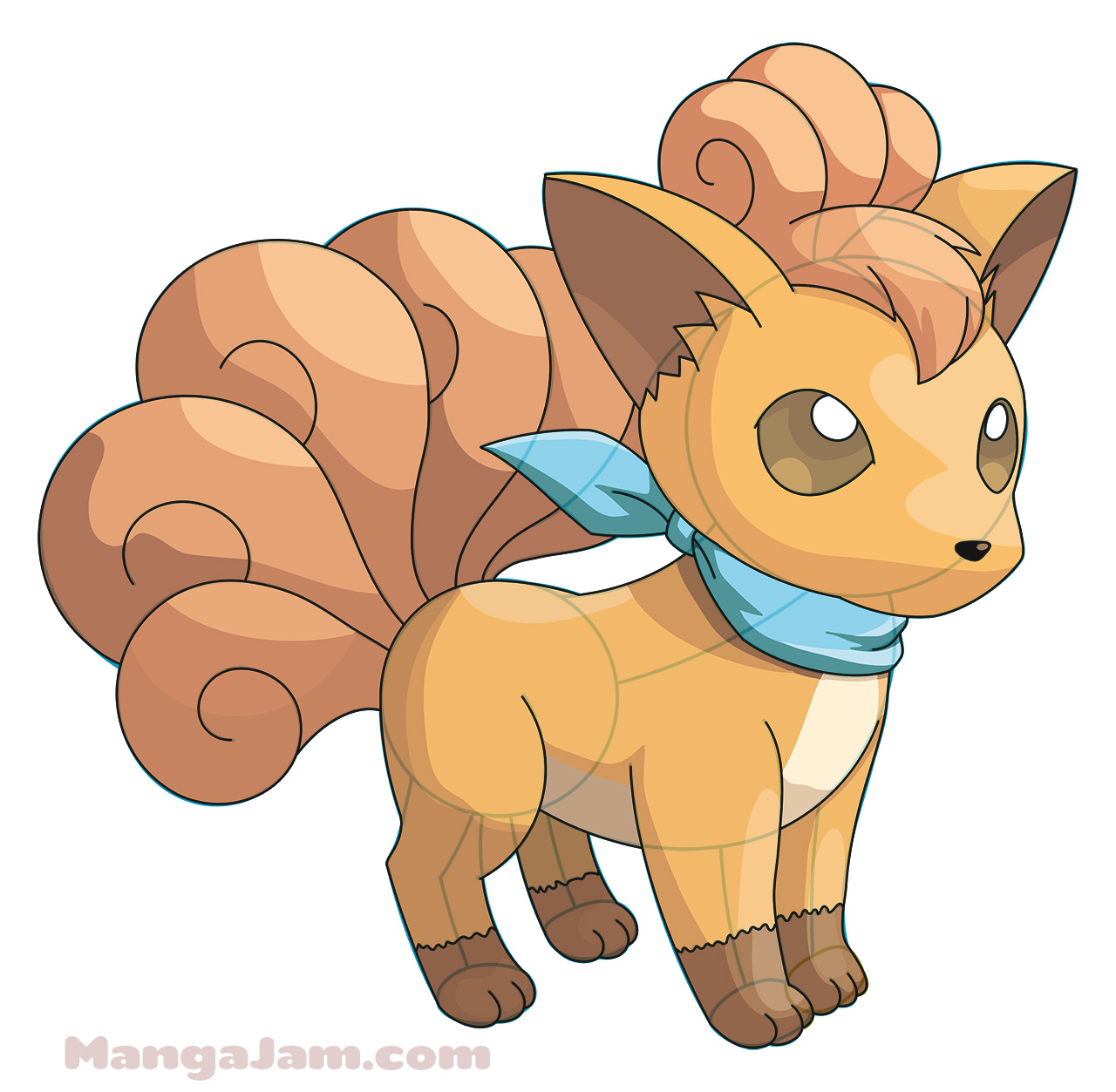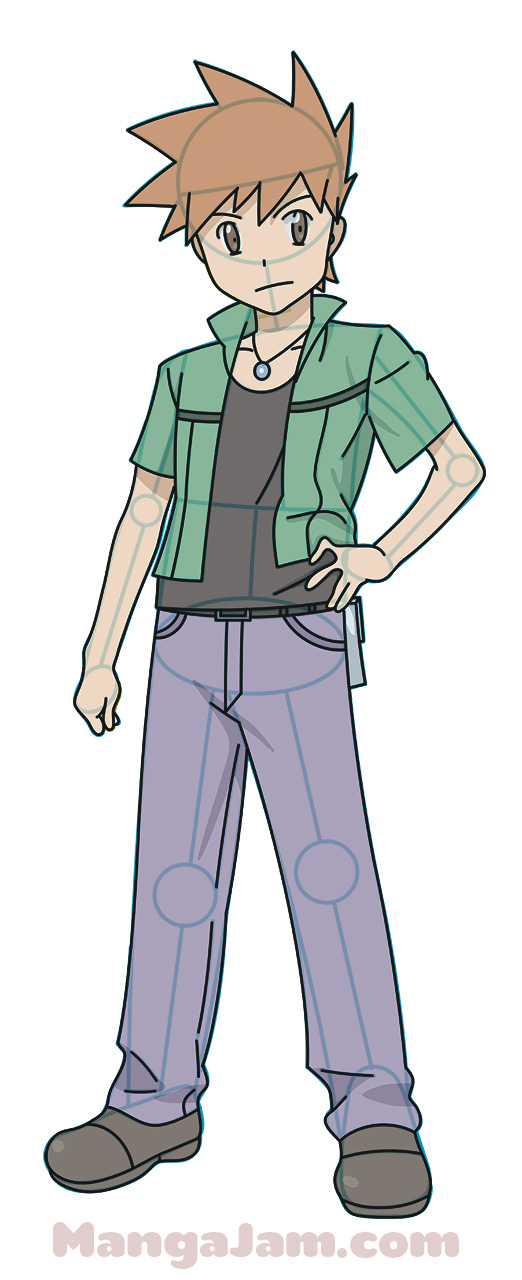Click here for more Pokemon tutorials
Welcome back mangakas! Today on how to draw manga in 3d we’re going to be drawing Bulbasaur from the Pokemon series. If you’ve missed any of our older Pokemon characters check out some of our previous tutorials as there is quite a collection. Although Bulbasaur might look like a cute turtlish companion, make no mistake, he’s a dangerous threat to any foe. His powers derive from the ‘bulb’ on his back, hence his name, that can spit seeds and snake out vines and leaves to entangle his enemies. And, even if someone is lucky enough to land a hit, Bulbasaur’s bulb gives him regenerative powers and can even store sunlight in his bulb to fire off a powerful SolarBeam attack. That’s one cute Pokemon 🙂 If you’re interested in learning how to draw more Pokemon characters click on the Pokemon tag in the tag cloud on the right of the page and you’ll see all of our Pokemon drawing tutorials. Let’s get our pencils and eraser ready and begin!
Step 1
Step 1: As any returning mangaka will know the blue lines you see in this tutorial are all construction lines and will be erased later on. So it’s important that you don’t press too hard on your pencil when drawing your own construction lines. The final lines you will see in black towards the end of the tutorial and you can do your permanent lines in pen if you would like. We’re going to begin today by drawing our head and body shape. As you can see the head shape overlaps the body shape (overlapping 3D principle). We should start with the head shape which is slightly trapezoidal but a bit more spherical. Think of a turtle’s head and that’s about the shape we want. The body shape will be an ellipse; the bottom part of the ellipse should curve back upward to touch the bottom of the head shape.
Step 2
Step 2: Now that we have our basic shapes we’re going to work on the legs and bulb. The shapes of the legs are slightly irregular and difficult to describe so do your best with what you see. Here are some tips: the leg furthest to the left should touch the bottom of the head and body shapes; the two legs on the right will overlap the body shape; the leg furthest to the right should curve back up and suggest a hip joint. Once you’ve got his legs in place we’ll draw in his bulb. It has an onion like shape and the line should touch about the middle of the head. The back portion of the bulb should touch the point where the body shape and the leg on the right touch.
Step 3
Step 3: Great work everyone! It’s time to draw the eye line, nose line and center line for the head that will help us to situate Bulbasaur’s features in the next step. Here, let’s start by dividing the head shape into thirds, this should give us our eye and nose line. Next draw the center line starting from the middle of the top of the head (where the bulb line touches the head) and curves to the left before touching the bottom of the head shape. Because Bulbasaur is turned slightly to face us the features on the right side of his face and body will appear larger than those on the left (size 3d principle), and that’s why we need the center line to curve.
Lastly, before moving on we’ve got to add Bulbasuar’s ears. Two tent like shapes should do the trick with the ear line on the right touching the body and head shapes. Although they are approximately the same height, the ear on the right will look larger because it should appear closer and secondly because his head should block our ability to see the full ear on the left (our overlapping and size 3d principles).
Step 4
Step 4: Before starting this step you might want to take a minute to lighten all of the construction lines we’ve made so far. We’re going to be drawing some details here so you might also want to use a thinner or sharper pencil. Let’s start this step by drawing Bulbasaur’s eyes. They both should be drawn on the far sides of the head with the eye on the right larger than that on the left (size 3d principle). We can draw two shovel like shapes for the eyes between the eye and nose line on the head. Add a slightly curving line inside each eye for the eye lid. Then, add a dash over the inside corner of both eyes for his eye brows.
Great, once we’ve got the eyes done let’s move on to the mouth. Bulbasaur has got a great big smile on his face either because he’s happy to see you or not. Either way, let’s draw a longer upper lip as a curving line across the lower third of the head and add a shorter lower curving line for the lower lip.
Now, for the last part of this step we’re going to go over the major head and body shapes and add details to the feet. Let’s start with the head and notice that there is an empty space under the ear on the left and the line for the ear on the right terminates inside the body shape concealing the neck and back behind the head and ears (3d overlap principle). Then, from the point where the ear on the right touches the body shape we’ll continue to outline the body shape down to the legs on the right.
When we get to the bottom of the first leg there are a few things to notice. Firstly, we’ll be adding 3 triangular shaped toes to each of Bulbasaur’s 3 legs and we’ll be adding a small 4th leg with a single toe that we can see. The second thing to notice is that the two legs on the right will look as though they are touching so we might need to adjust our lines here to make it. Continue tracing the 3 legs we’ve drawn so far adding the toes as you go along. We’ll need to connect the two front legs (left and center leg) with a line for his body. And, lastly, underneath that line we’ll add a smaller, shorter 4th leg with a single toe. Once you’ve got all that in place we can move on to our next step.
Step 5
Step 5: Well, after such a long step we’ve got an easier one for us here. Bulbasaur’s bulb still looks pretty plain so we should work on it a bit to make it more plant-like by adding petals to his bulb. We need to draw three lines with points at the top to delineate the petals. It might be easiest to begin with the top line, then the middle and finally the bottom. Notice that with the middle line the point at the top will look longer to cover the petal above it that is actually behind it (our overlapping 3d principle). Once you’re done, we’ll move on.
Step 6
Step 6: What kind of a dinosaur would you be without some scales and spots? In this step, mangakas, we’re going to add some irregular shapes to Bulbasaur for his spots and scales. I’ve done three irregular triangle shapes on his head, at least one on each leg and one on his back. Before finishing up, let’s add a vertical ellipse in the eye on the right and a half ellipse in the eye on the left.
Step 7
Step 7: Excellent work mangakas! Now, take out your eraser and lighten all of the construction lines we’ve made so far until they are just visible. Then we’ll get out our pen or finishing pencil and trace over our lines to get our final drawing. I missed a few details in previous steps that you can see here, but we can add them in pen with no problem. There is a short line just above the ear on the right that should extend about halfway up the bulb. Also, inside the mouth there should be two triangle shapes for teeth in each corner and a small line just next to the tooth on the left for Bulbasaur’s tongue. Have you got it? Great! Bulbasaur’s eyes are typically red, but we’re not going to be colorizing today. Stay tuned for a color tutorial soon. In the meantime, you can trace the ellipses in Bulbasaur’s eye and fill in the space outside of the iris in black. That should give him the look you’re going for.
Step 8
Click here for more Pokemon tutorials
Step 8: That’s it, mangakas! Use your eraser to completely erase any remaining construction lines and hear him roar, Bulbasaur! If your goal is to become a great mangaka make sure to draw Bulbasaur again from memory. Then compare the final drawing with the original and correct any mistakes you might have made. Try once again from memory. This is the best way to build a huge library of shapes that you can use in the future for your own manga characters.
Draw with passion! -_^ Hiroshi













1 comment
Comments are closed.